I know an elder who invested 100,000 yuan in the crypto space and currently has a market value of 42 million. He once said to me something that enlightened me: "This market is filled with a crowd of people; all you need to do is control your emotions, and this market becomes a cash machine!"
In the crypto space, the trading strategy is your 'secret weapon'. The following catchphrases are the crystallization of practical experience; make sure to collect them!
Entry section: Testing the waters in the crypto space, preparing to proceed; entering steadily, refusing to rush.
Sideways section: Buy during low sideways movements, it's the right time to accumulate; during high sideways movements, decisively sell without hesitation.
Volatility section: Sell at highs, enter quickly at lows; watch and reduce trading during sideways movements. Sideways means replacing decline with stability; hold tight to your assets, as a surge may occur in the next moment; during rapid surges, be wary of sudden drops, ready to secure profits at any time; during gradual declines, it is a good time to gradually add to your position.
Timing for buying and selling: Don't chase highs, don't sell; don't dive, don't buy; during sideways movement, don't trade. Buy on bearish candles, sell on bullish candles; operate counterintuitively to stand out. If there is a significant drop in the morning, buy; if there is a significant rise in the morning, sell; do not chase highs in the afternoon; if there is a significant drop in the afternoon, buy the next day; do not panic sell during a morning drop; if the price is stagnant, take a break; average down on being stuck to seek breakeven; excessive greed is not advisable.
Risk awareness section: A calm lake can rise high waves; there may be great waves ahead; after a significant rise, a pullback is inevitable, with candlesticks showing a triangle for several days. In an upward trend, look for support; in a downward trend, look for resistance. Overtrading is a taboo; one should know to stop in the face of volatility, seizing opportunities to enter and exit.
Trading in cryptocurrencies is essentially about trading psychology; greed and fear are major enemies. Be cautious about chasing highs and selling lows, maintaining a calm mindset for peace of mind.
In addition to the catchphrases, I have also compiled several super practical trading methods, from which both novices and experienced players can benefit.
Swing trading method: Most market movements are in a volatile pattern, using high selling and low buying within the box is the foundation for stable profits. With the help of the BOLL indicator.
Combine box theory with technical indicators and graphics to pinpoint resistance and support. Follow short-term trading principles and avoid greed.
Volatility trading method*: After a long period of consolidation, the market will choose a direction. Entering after the breakout can yield quick profits, but it requires precise timing for the breakout.
One-sided trend trading method*: After the market breaks the range, a one-sided trend will form; trading with the trend is key to profit. Enter during pullbacks or rebounds, referencing indicators such as candlestick patterns, moving averages, BOLL, and trend lines; skilled use will allow you to navigate smoothly.
Resistance support trading method*: When the market encounters a key resistance support level, it often faces resistance or gains support; entering at this time is a common strategy.
Use trend lines, moving averages, Bollinger Bands, parabolic indicators, etc., to accurately determine resistance and support levels.
Pullback rebound trading method: After significant rises and falls, a brief pullback or rebound will occur, seizing the opportunity to easily profit. This primarily relies on candlestick patterns, and good market sense will help you accurately capture highs and lows.
Time-framed trading method: The morning and afternoon sessions show little volatility, suitable for conservative investors; although the profit-taking time is long, the market is easier to grasp. The evening and early morning sessions show high volatility, suitable for aggressive investors; quick profits are possible, but the difficulty is high, requiring strict technical and judgment skills.
By following Awen, you are sure to gain insights. Helping others is helping oneself; I hope that regardless of how the market changes, we can continue to walk together and smile at the crypto space ten years later.

Trend follower's secret technique: Lock in a tenfold opportunity over ten years.
Wealth code specializing in long-term trends:
Halving cycle layout: 180 days before Bitcoin's halving, pre-position BTC, BCH, and other halving coins, holding them for 30 days post-halving.
Leading coin rebound law: When the market's leading coin rises by 200%, prioritize selecting second-tier coins from the same sector that have not risen by more than 50%.
Technical triple confirmation: Weekly MACD golden cross + daily breakout from the box + hourly volume spike encapsulating the bearish candle, forming a golden buying point.
Institutional position analysis: Glassnode data shows that when large addresses continuously accumulate, coupled with a surge in on-chain trading volume, it is a signal to initiate.
Bear market dollar-cost averaging strategy: Invest 10% of principal monthly, choosing blue-chip coins like BTC, ETH, and after 12 months of continuous investment, the return exceeds 300%.
Risk warning: The above strategies need to be adjusted based on real-time market conditions. It is recommended that novices first verify with a simulated account, and that each trade's loss does not exceed 2% of total funds. The market is risky; invest cautiously.
1. Introduction
At this stage, you may have mastered knowledge of various chart patterns, such as the double bottom, ascending triangle, and inverse head and shoulders, as shown in the diagram below.

However, as you understand, not all chart patterns will consistently perform effectively. In this situation, when these chart patterns fail to achieve the expected results, what measures should you take? As shown in the diagram below.
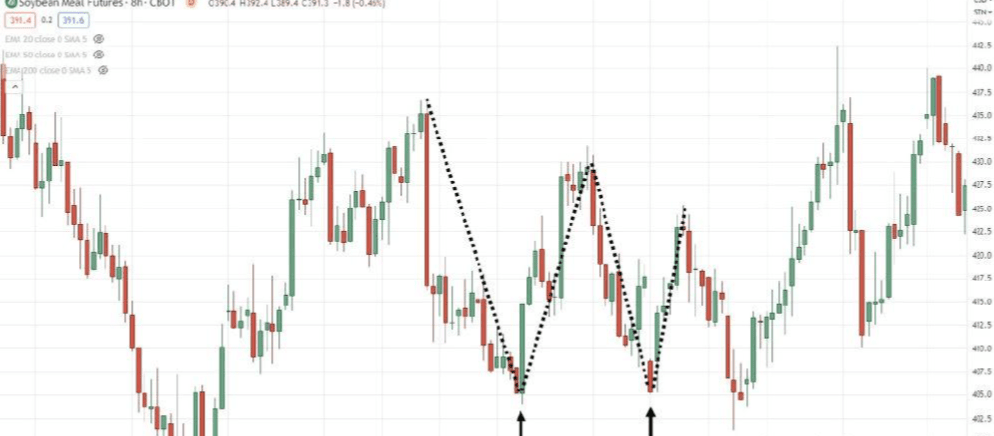
When the range involved further expands, how will you take action? As shown in the diagram below.
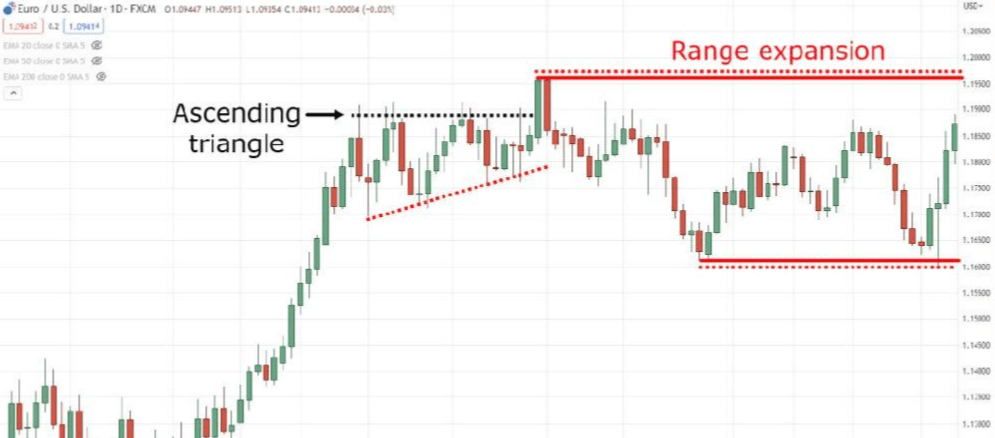
At that time, what kind of trading activities do you plan to conduct in the market? As shown in the diagram below.
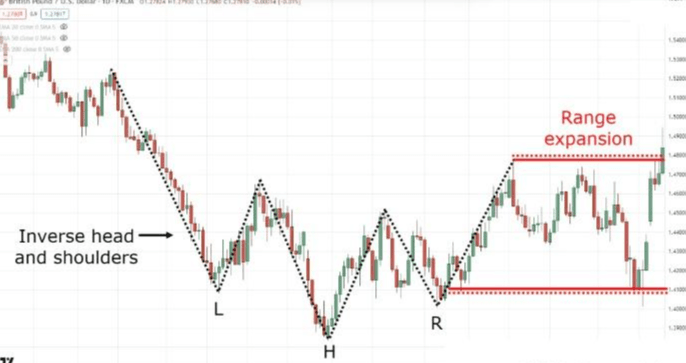
At this moment, the triple bottom pattern reveals its unique application value, as illustrated in the diagram below.
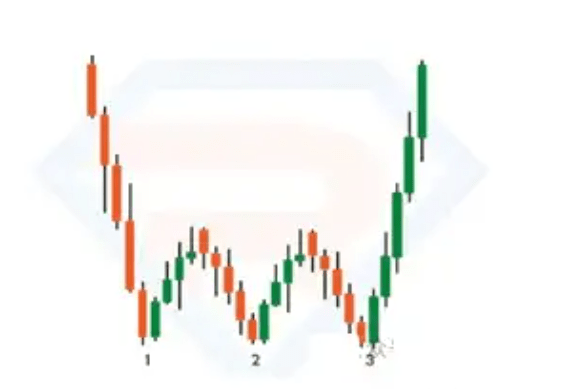
The triple bottom pattern is one of the rarer chart formations in the current market; however, it remains an indispensable tool in traders' toolboxes amidst market volatility.
In this guide, you will learn the following:
(1) A comprehensive guide to the operational mechanism of the triple bottom pattern;
(2) How to avoid misjudging the triple bottom pattern (and the appropriate measures to take in this situation);
(3) Correct methods for trading and analyzing the triple bottom pattern;
(4) A step-by-step procedure on how to accurately define and execute triple bottom trades.
2. The truth about what the triple bottom is and how it works.
The triple bottom pattern is like a talented superstar that has stepped onto the market stage with its unique gift. It begins at the neckline, which serves as the support of the entire structure, as illustrated in the diagram below.
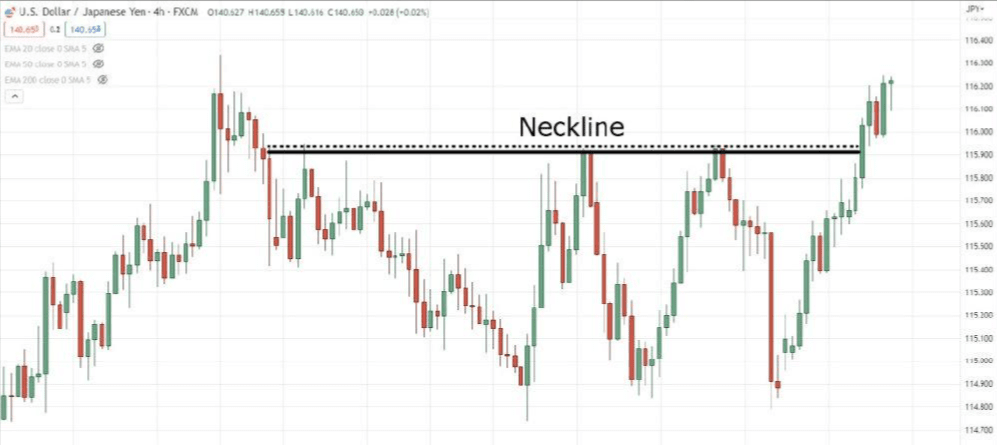
Subsequently, in the dazzling complex performance presented by the market, the three bottoms appear in sequence, each playing an indispensable role in this captivating formation, as illustrated in the diagram below.
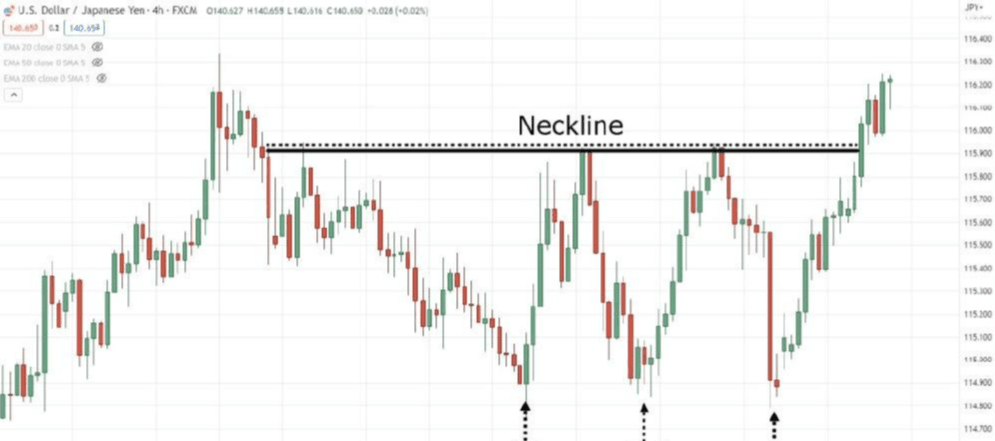
This is like a meticulously choreographed synchronized dance, which becomes the focus due to its eye-catching nature and lays the foundation for potential trading opportunities. This pattern is indeed easy to identify.
Now that you understand what this pattern looks like, how is the triple bottom pattern formed? If you are pondering this question, you are moving in the right direction, as understanding 'why' it occurs is often more critical than merely knowing 'what' occurs.
In this guide, we mainly discuss the following three reasons that lead to the formation of the triple bottom pattern.
(1) The market's indecision.
Envisioning the market as a capricious individual, whose decision-making process is indecisive, is akin to a friend who can never decide where to have dinner or which movie to watch. Thus, the triple bottom pattern emerges, a model born from the unstable state caused by the market's indecision, as shown in the diagram below.
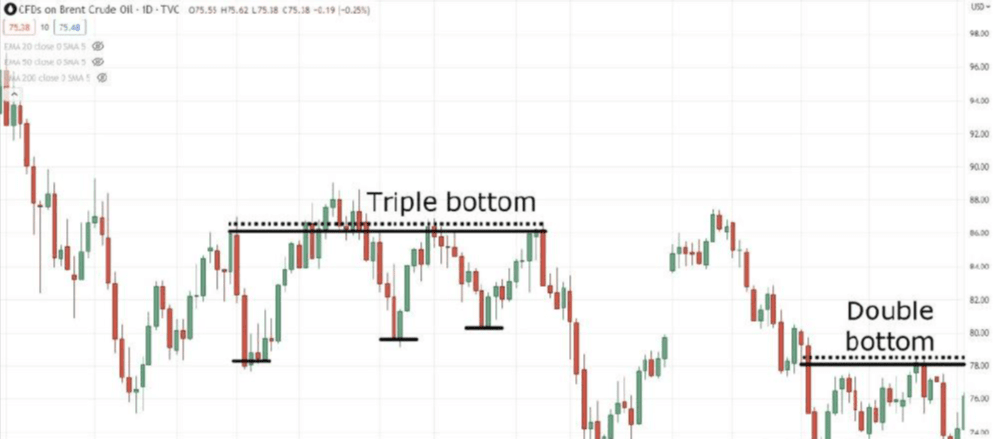
Just as the market seems to say: I cannot decide which path to choose, have you noticed how the price range in the previous example keeps expanding? This is like a paused moment of confusion, yet it provides traders like us with the opportunity to leverage the upcoming market decision. Therefore, essentially, we are discussing that the triple bottom pattern is a direct product of market indecision.
(2) Development takes time.
This pattern tends to develop gradually at its unique rhythm; however, this only makes it like a meticulously slow-cooked dish, where the waiting process is worthwhile, akin to watching a suspense movie where well-informed viewers can foresee the climax. The market tests your patience, teasing you with its delicate fluctuations. For those willing to wait patiently and observe carefully, the triple bottom pattern offers an opportunity that may lead to substantial profits. Therefore, remain calm and let this pattern reveal its enticing trading opportunities in due time. In fact, to further illustrate this principle, you can effectively utilize the triple bottom pattern when the following situations arise.
(3) You missed the double bottom pattern.
If you missed the double bottom pattern, as shown in the diagram below.
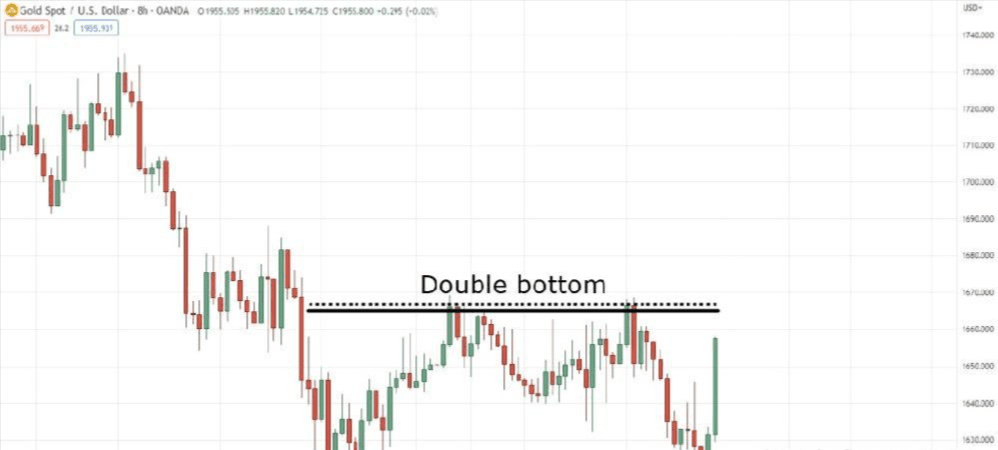
You need not toss and turn in regret, as the triple bottom pattern can now turn the tide, bringing you another opportunity to participate in the market, as shown in the diagram below.
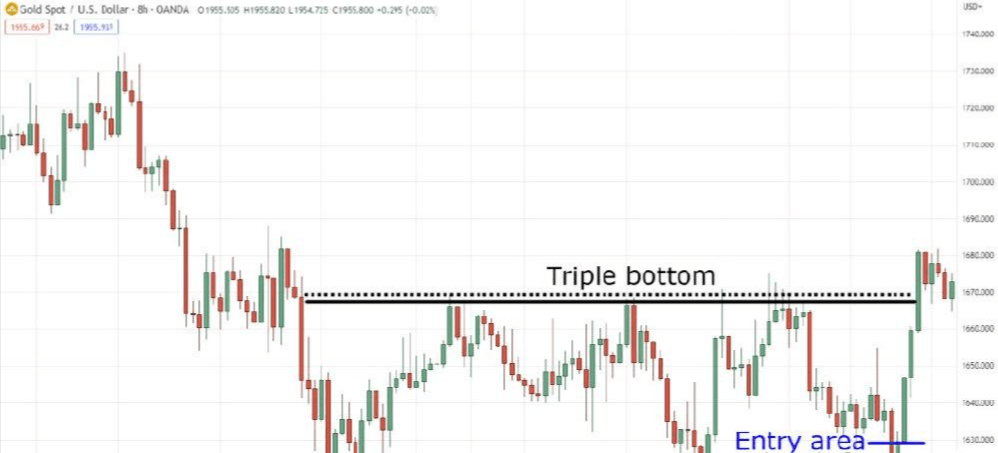
This is akin to unexpectedly discovering a hidden treasure chest in despair, believing that all hope was lost; thus, this pattern provides an additional entry opportunity.
Now, I understand that trading the double bottom pattern may seem more appealing, but the key lies in whether you can seize the opportunity. For cautious traders seeking more confirmation, closely watching the triple bottom formation is worthwhile, as it is a pattern that can bring redemption, excitement, and substantial profits, adding value to your trading charts. Since you now understand what the triple bottom pattern looks like and how it functions, I will next explain the circumstances under which you should not trade this pattern. Remember, all trading patterns have their own advantages and limitations.
3. The biggest mistake when trading triple bottoms: Avoid these traps.
(1) Error 1: Trading in the middle of the triple bottom pattern.
Firstly, trading within the price range is like trying to squeeze into a pair of overly tight jeans, inevitably causing discomfort. Remember, the triple bottom pattern usually forms under conditions of market indecision, where the market behaves like a child in a candy store faced with many tempting choices. Therefore, resist the impulse to frequently enter and exit trades during the formation of the pattern; instead, patiently wait for the market to make a clear decision.
In summary, trading should be avoided in the middle phase of the pattern establishment, as shown in the diagram below.
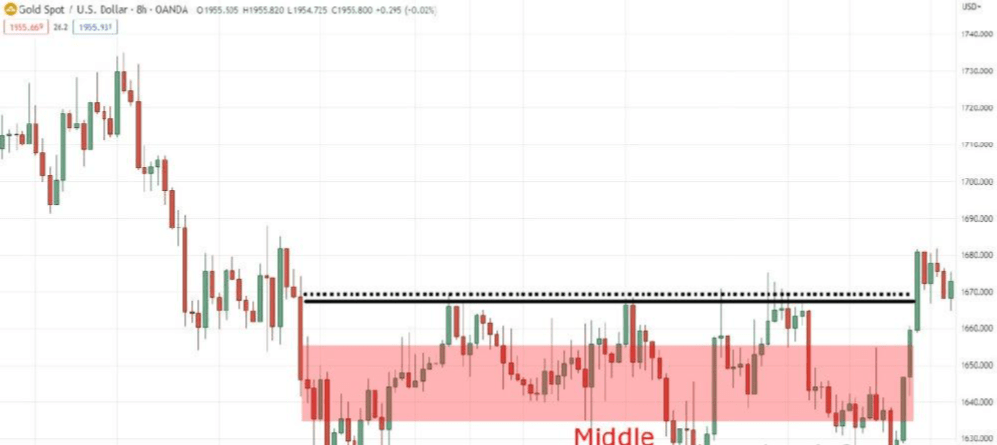
Please focus on the value area, known as support and resistance levels, as shown in the diagram below.

(2) Error 2: Blindly trading at highs and lows
What does this mean? Should we not only avoid trading the middle part of the triple bottom pattern but also find trading highs and lows inappropriate? You should be aware that the triple bottom pattern is renowned for its frequent false breakouts, as illustrated in the diagram below.
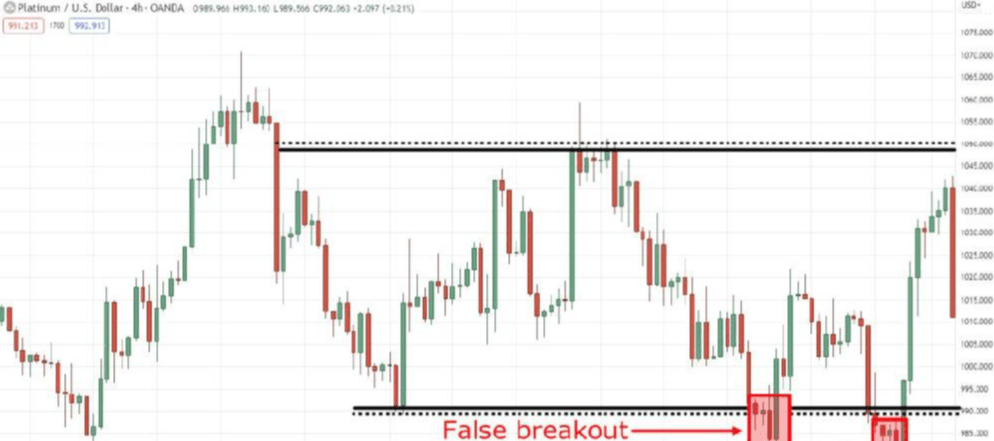
This is due to the inherent characteristics of range markets, which expand and contract. A triple bottom could even evolve into a quadruple bottom, akin to a prankster lurking in the shadows, ready to jump out and give you a scare. Therefore, do not blindly chase the peaks and valleys of prices like an ignorant squirrel; instead, you should wait for market confirmation before trading, meaning you should patiently wait for the actual breakout after the third bottom occurs, as shown in the diagram below.

And it should be confirmed upon the price closing within this range, thus serving as valid confirmation of the third bottom formation, as shown in the diagram below.
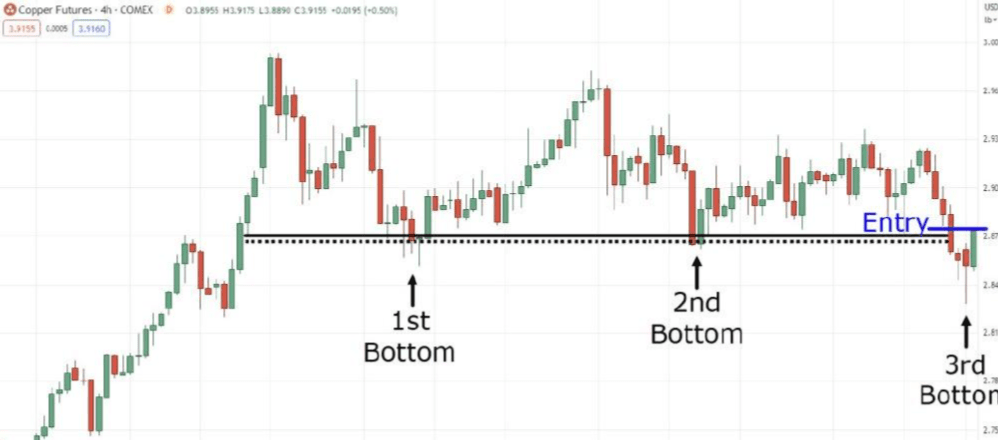
Therefore, reaching highs and lows does not constitute a sufficient reason to trade immediately. Instead, you should remain alert and wait for the necessary additional confirmation signals.
(3) Error 3: Using the double bottom pattern to judge market direction.
Now, let us clarify one point to correct a common misconception: while the triple bottom pattern may play a crucial role in the market, it does not possess the oracular ability to predict market direction. This means that even if you identify the triple bottom pattern, the market is not necessarily obliged to break to higher levels; the following situations may also occur, as shown in the diagram below.

This is akin to expecting to predict the next day's lottery numbers through a crystal ball, which is almost impossible. Therefore, you should not solely rely on the triple bottom pattern to determine the subsequent market trend; you should comprehensively analyze other relevant factors and regard the triple bottom pattern as one of the auxiliary tools, rather than the sole decision-making indicator.
(4) Error 4: Over-relying on 'textbook-style' triple bottoms.
When discussing the triple bottom pattern, do not overly cling to the definitions in traditional textbooks, as shown in the diagram below.
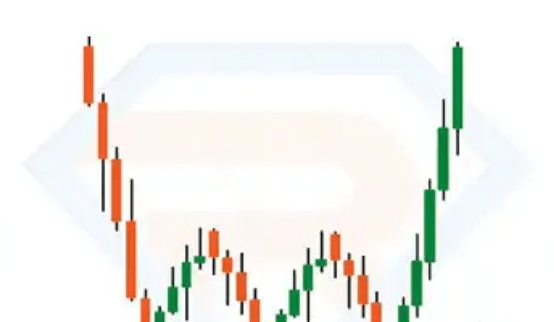
This pattern is like a chameleon, with ever-changing forms; each twist brings new surprises, indicating the existence of various effective triple bottom variants, just as you observed earlier, as shown in the diagram below.

And this one, as shown in the diagram below.

Therefore, please set aside your rigid expectations for the pattern and instead appreciate the beauty of its diverse forms. The key lies in those 'sharp bottoms' that you identify on the chart.
Now, you may be contemplating: I already know how to identify this pattern and the behaviors to avoid during trading. How should I proceed with trading? If this is your question, now is the time to showcase your trading skills, as I will next reveal three key market trends to focus on when trading the triple bottom pattern.
4. Ideal strategies for successfully trading the triple bottom pattern
(1) Ensure the triple bottom is in the existing upward trend.
By ensuring your trading actions align with the current market upward trend, as shown in the diagram below.
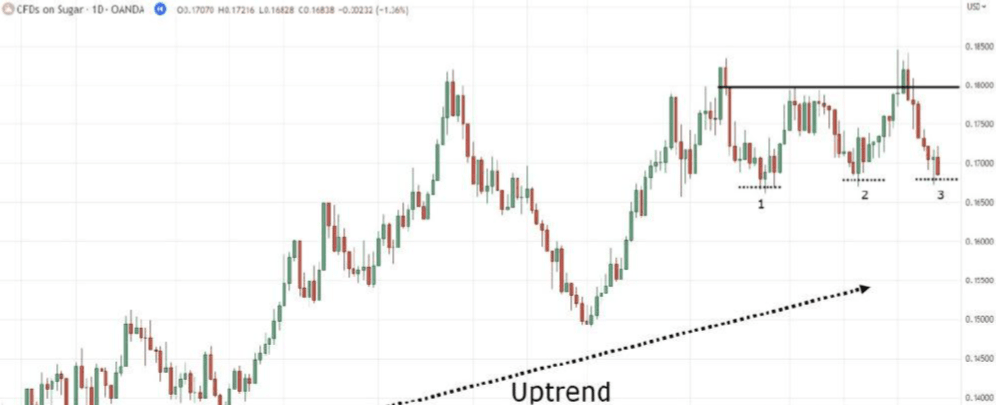
You are increasing the probability of trading success and aligning with the market's rhythm, focusing on this upward trend, just like an experienced dancer seeking the ideal partner, ready to elegantly spin and immerse yourself with the unfolding of the triple bottom pattern.
(2) Look for false breakouts or accumulation.
When you observe a false breakout at the third bottom, as illustrated in the diagram below.
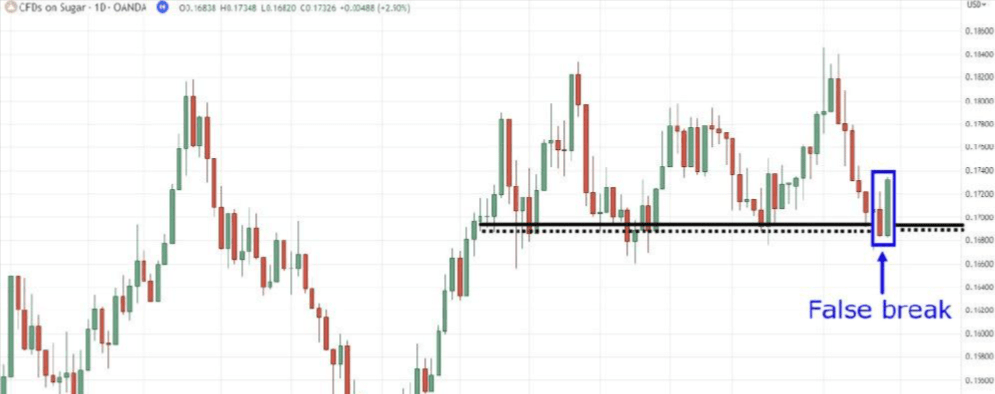
This is like noticing that your dance partner pretends to be tired on the dance floor but soon revitalizes with their talent. This indicates a signal, suggesting that the pattern is poised to take off and ready to seize the market's spotlight, as illustrated in the diagram below.
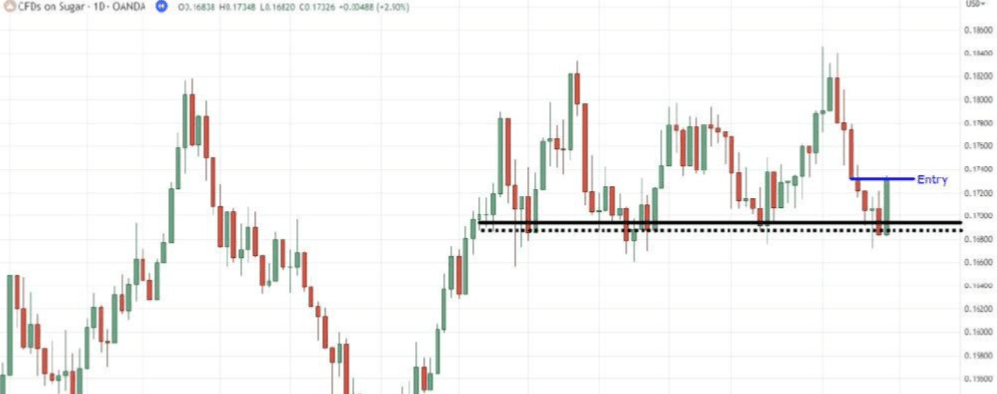
From another perspective, if you encounter the following situation: failed to seize the entry opportunity of the double bottom pattern or missed the false breakout trading opportunity of the triple bottom pattern, do not worry, as there are still opportunities waiting for you. This is because, if you observe price accumulation at the highs, as shown in the diagram below.
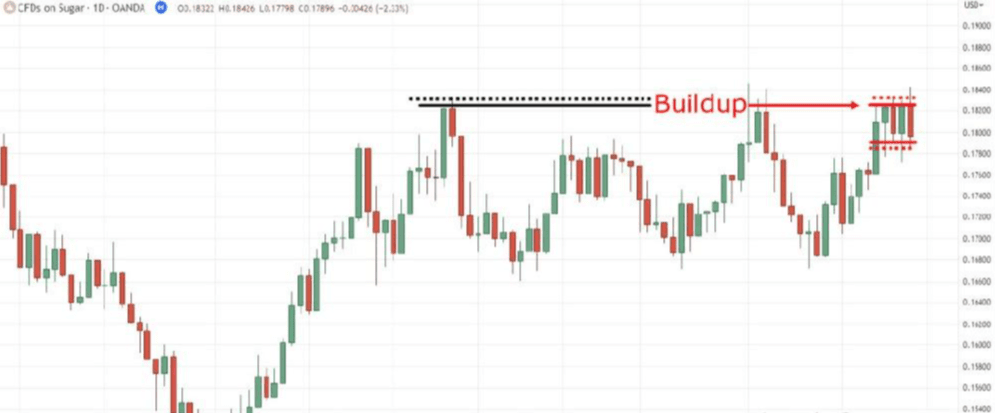
This is like the moment before an electrifying elevator starts, as this phenomenon indicates that the triple bottom pattern is preparing for a potential energy-rich breakout, as illustrated in the diagram below.
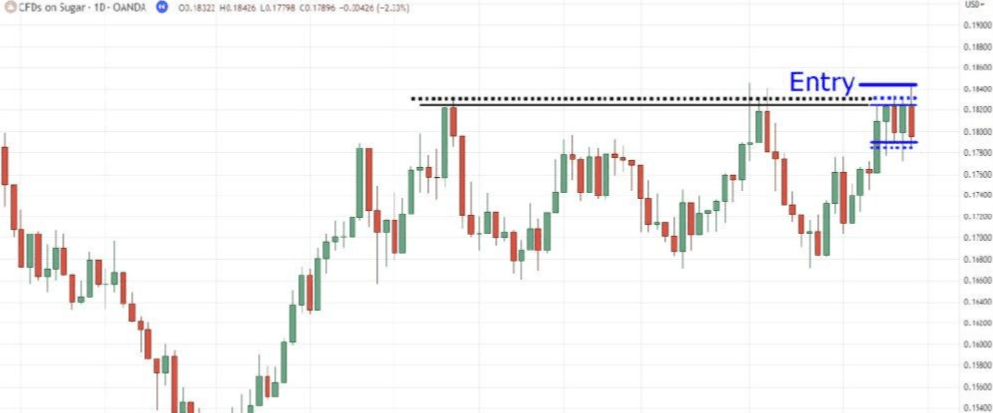
Therefore, please continue to pay attention to these cutting-edge market trends and be ready to showcase your trading abilities on the market stage. At this stage, you have mastered all the necessary key elements to successfully execute trades based on the triple bottom pattern, but as you know, the effectiveness of these tools depends on how you use them. If you have been trading similar double bottom patterns for a long time, then you are well-prepared. However, if you seek a clear and straightforward guide to understand how to utilize the triple bottom pattern for market discovery, trading, and trade management, please continue reading the following content of this guide.
5. Mastering the triple bottom: A trading strategy that allows you to dance in profits.
(1) Step 1: First determine the upward trend within the daily time frame.
Consider it as finding the ideal rhythm that lays the foundation for an engaging performance, exploring those continuously rising highs and lows, which symbolize a strong upward trend, as illustrated in the diagram below.
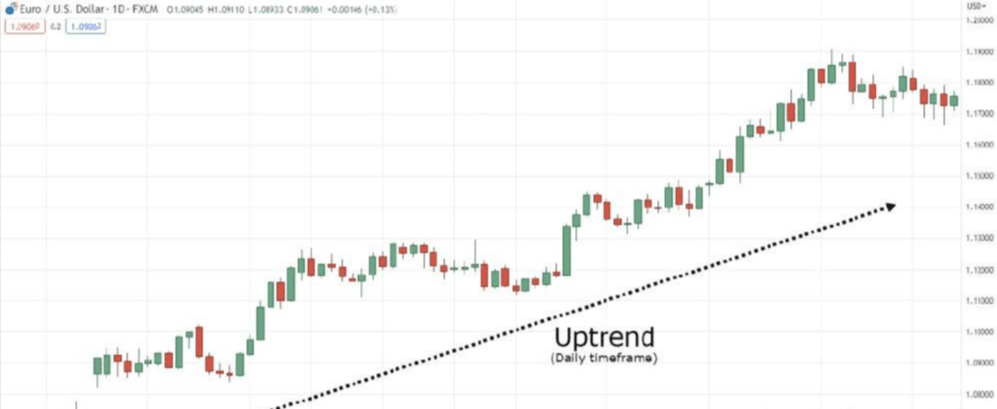
Once you confirm this upward trend, you advance to the next stage, closely following the market rhythm.
(2) Step 2: Identify potential triple bottoms within the 4-hour time frame.
At this moment, please shift your observation focus to the 4-hour chart, where the potential triple bottom pattern will appear vivid. Compare this process to a dance choreography, where each step carries a specific goal; identify the triple bottom pattern, which connects three different bottoms through the neckline, as depicted in the diagram below.
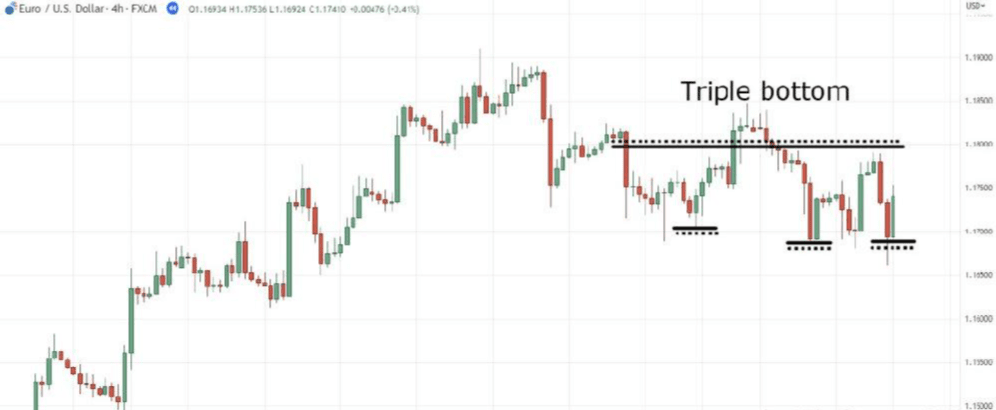
This is like observing a group of dancers synchronizing their steps, weaving striking patterns on the dance floor. Once you identify the masterpiece of this triple bottom formation, you should begin preparing for a precise trade entry.
(3) Step 3: Trade false breakouts at 3 points.
This is like executing a stunning spin or rapidly changing direction on the dance floor, leaving all viewers in admiration, as the market briefly dips below the third bottom and then quickly rebounds, as shown in the diagram below.
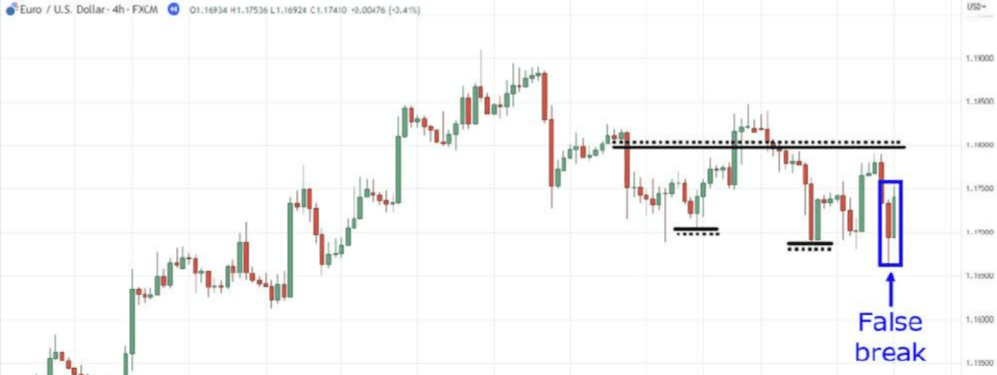
This is a sign that the pattern is poised to take off, ready to become the focus of the market. Therefore, please join the trade like an experienced dancer, riding this momentum to showcase your trading skills and seize the market's first-mover advantage, as depicted in the diagram below.
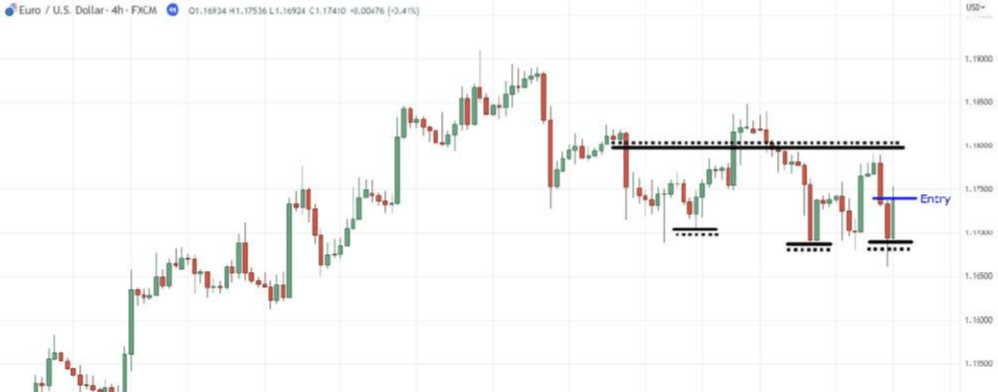
Timing is crucial; patiently wait for that false breakout to occur and swiftly take action.
(4) Step 4: Accumulation at the neckline with reduced scale.
At this moment, it is time to enhance your trading performance, and you may wonder: how to achieve this? By gradually reducing your trading size near the neckline, as shown in the diagram below.

Consider it as a grand upgrade in dance choreography, where energy surges to new peaks. When the price decisively crosses the neckline, it indicates that the triple bottom pattern is about to unleash its full market potential. In this situation, how should you act? Simply put, you should increase your position size, expanding on your initial trade to maximize your profit potential, as shown in the diagram below.

This is like the crescendo in a musical piece, where the key is that this breakout provides investors with an opportunity to ride the wave of victory.
(5) Step 5: Use the 20-period moving average + trailing stop-loss.
Since you have ventured into this field, how should you manage it? In this situation, I recommend using the 20-period moving average as a trailing stop-loss tool, as shown in the diagram below.

This indicator is like a trustworthy dance partner, ensuring your safety on the trading stage. As prices fluctuate favorably for you, utilize this dynamic indicator to adjust your stop-loss position to safeguard your profits, as depicted in the diagram below.
Here are additional points you should understand: You always have the option to choose between the 3rd and 4th stages. For traders inclined to take on higher risks, you may choose to trade in the 3rd and 4th stages; if you are a more conservative trader, you can choose to enter the market when the price breaks the neckline (i.e., the 4th stage); if your trading style lies between the two, consider taking action in the 3rd stage without reducing your position, but rather expanding horizontally in the 4th stage.
Therefore, please put on your trading 'battle boots', practice these steps, and let this simple triple bottom strategy become your ticket to trading success.
6. Conclusion
Here is a summary of the core points of this guide:
(1) The triple bottom pattern provides a second entry opportunity for traders who failed to seize the double bottom opportunity.
(2) It consists of a neckline and three distinct bottoms, usually forming during periods of market indecision and requiring a certain amount of time to develop.
(3) When trading the triple bottom, avoid common mistakes, such as trading within the price range and over-relying on textbook patterns.
(4) The best trading method is to align with the existing upward trend of the market and pay attention to false breakouts at lows or price accumulation at highs.
(5) A simple trading strategy includes identifying an upward trend, discovering the triple bottom pattern, trading false breakouts, adjusting position size during breakouts, and using the 50-period moving average as a trailing stop-loss tool.

Simple and practical cryptocurrency trading tips to help you profit steadily.
1. Invest in batches: Suppose you have 10,000 yuan, divide it into five parts, and use only 2,000 yuan for each trade.
2. Testing the waters with investment: First, try buying a coin with 2,000 yuan.
3. Add to your position after a drop: If the coin price drops by 10%, add 2000 yuan to your position.
4. Take profits when the price rises: If the coin price rises by 10%, sell part of it in time to lock in profits.
5. Repetitive cycle: Continuously buy and sell until funds run out or coins are sold out.
Strategic advantage: The benefit of this strategy is that even if the coin price drops, you can respond calmly. By entering in batches, you avoid the risks of one-time investment. Even if the coin price drops by half, you are only gradually increasing your position. And each time you sell, you can lock in 10% profit. For example, if you have 100,000 yuan, investing 20,000 each time allows you to earn 2,000 each time.
If you're also a tech enthusiast, delving into technical operations in the crypto space, consider following Awen for the latest crypto intelligence and trading tips!



